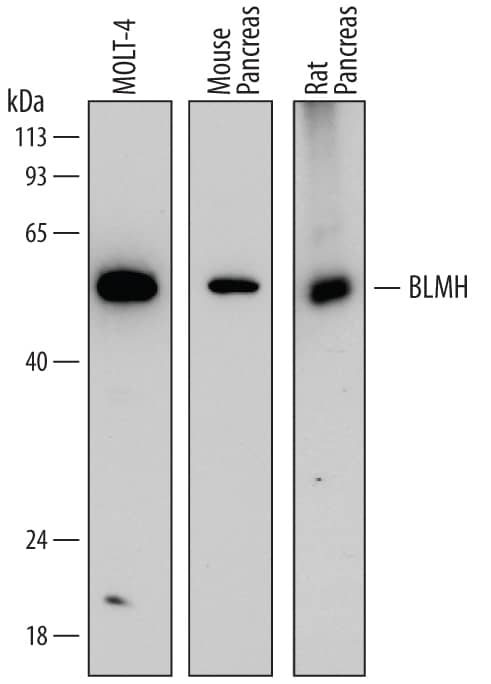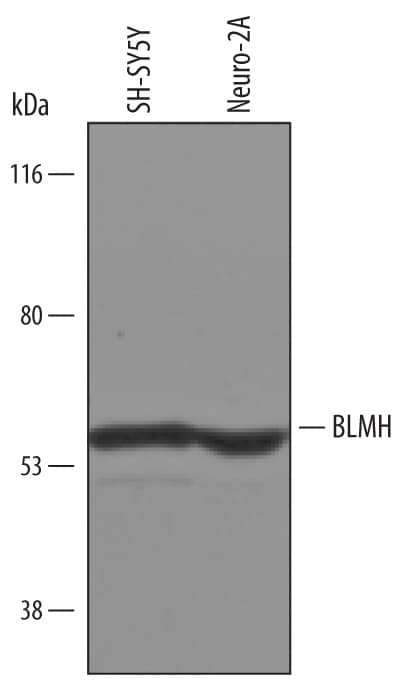BLMH/Bleomycin Hydrolase Products
Bleomycin hydrolase (BLMH) is a cysteine peptidase of the papain superfamily. It is named for its ability to hydrolyze the anti-tumor agent bleomycin and inactivate it. It has a papain-like catalytic triad (Cys-His-Asp) with optimum activity at neutral pH. In mammals it is expressed ubiquitously in all types of tissues and its expression is up-regulated in many tumors. It is present in the cytoplasm as homohexameric protein of approximately 300 kDa. In addition to its aminopeptidase activity, it has homocysteine-thiolactonase activity. The normal physiological function of BLMH is not clear. BLMH inactivates bleomycin, a glycopeptide anti-cancer agent, by deaminating it. BLMH has been suggested to play a role in the generation of MHC class I-presented peptides. Diminished BLMH activity may contribute to the pathology of Alzheimer's disease. It is inhibited by cysteine protease inhibitors such as N-ethylmaleimide, iodoacetamide, para-hydroxymercuribenzoate, and E-64.
38 results for "BLMH/Bleomycin Hydrolase" in Products
38 results for "BLMH/Bleomycin Hydrolase" in Products
BLMH/Bleomycin Hydrolase Products
Bleomycin hydrolase (BLMH) is a cysteine peptidase of the papain superfamily. It is named for its ability to hydrolyze the anti-tumor agent bleomycin and inactivate it. It has a papain-like catalytic triad (Cys-His-Asp) with optimum activity at neutral pH. In mammals it is expressed ubiquitously in all types of tissues and its expression is up-regulated in many tumors. It is present in the cytoplasm as homohexameric protein of approximately 300 kDa. In addition to its aminopeptidase activity, it has homocysteine-thiolactonase activity. The normal physiological function of BLMH is not clear. BLMH inactivates bleomycin, a glycopeptide anti-cancer agent, by deaminating it. BLMH has been suggested to play a role in the generation of MHC class I-presented peptides. Diminished BLMH activity may contribute to the pathology of Alzheimer's disease. It is inhibited by cysteine protease inhibitors such as N-ethylmaleimide, iodoacetamide, para-hydroxymercuribenzoate, and E-64.
| Reactivity: | Human, Mouse, Rat |
| Details: | Rabbit IgG Polyclonal |
| Applications: | IHC, WB |
| Reactivity: | Human |
| Details: | Mouse IgG2b Monoclonal Clone #760239 |
| Applications: | WB, IHC, KO |
| Reactivity: | Human, Mouse |
| Details: | Sheep IgG Polyclonal |
| Applications: | WB |
| Reactivity: | Human |
| Details: | Rabbit IgG Polyclonal |
| Applications: | IHC |
| Source: | E. coli |
| Accession #: | Q13867 |
| Applications: | EnzAct |
| Source: | E. coli |
| Accession #: | Q8R016 |
| Applications: | EnzAct |
| Reactivity: | Human, Mouse, Rat |
| Details: | Mouse IgG1 kappa Monoclonal Clone #6# |
| Applications: | IHC, WB, ELISA, ICC/IF |
| Reactivity: | Human |
| Details: | Mouse IgG2a Kappa Monoclonal Clone #4A2 |
| Applications: | WB, ELISA |
| Reactivity: | Human |
| Details: | Rabbit IgG Polyclonal |
| Applications: | WB |
| Reactivity: | Human |
| Details: | Rabbit IgG Polyclonal |
| Applications: | WB |
| Applications: | WB |
| Applications: | ELISA |
| Applications: | ELISA |
| Applications: | AC |
| Applications: | AC |
| Reactivity: | Mouse |
| Details: | Rabbit IgG Polyclonal |
| Applications: | WB, ELISA, IP |
| Reactivity: | Human |
| Details: | Rabbit IgG Polyclonal |
| Applications: | WB, ELISA, IP |
| Reactivity: | Human |
| Details: | Rabbit IgG Polyclonal |
| Applications: | WB, ELISA, IP |
| Reactivity: | Mouse |
| Details: | Rabbit IgG Polyclonal |
| Applications: | WB, ELISA, IP |
| Reactivity: | Mouse |
| Details: | Rabbit IgG Polyclonal |
| Applications: | WB, ELISA, IP |
| Reactivity: | Human |
| Details: | Rabbit IgG Polyclonal |
| Applications: | WB, ELISA, IP |
| Reactivity: | Human |
| Details: | Rabbit IgG Polyclonal |
| Applications: | WB, ELISA, IP |
| Reactivity: | Mouse |
| Details: | Rabbit IgG Polyclonal |
| Applications: | WB, ELISA, IP |
| Reactivity: | Mouse |
| Details: | Rabbit IgG Polyclonal |
| Applications: | WB, ELISA, IP |
| Reactivity: | Mouse |
| Details: | Rabbit IgG Polyclonal |
| Applications: | WB, ELISA, IP |

![Western Blot: BLMH/Bleomycin Hydrolase Antibody [NBP1-88640] Western Blot: BLMH/Bleomycin Hydrolase Antibody [NBP1-88640]](https://resources.bio-techne.com/images/products/BLMH-Bleomycin-Hydrolase-Antibody-Western-Blot-NBP1-88640-img0005.jpg)



![Immunohistochemistry-Paraffin: BLMH/Bleomycin Hydrolase Antibody [NBP2-39023] Immunohistochemistry-Paraffin: BLMH/Bleomycin Hydrolase Antibody [NBP2-39023]](https://resources.bio-techne.com/images/products/BLMH-Bleomycin-Hydrolase-Antibody-Immunohistochemistry-Paraffin-NBP2-39023-img0007.jpg)

![Western Blot: BLMH/Bleomycin Hydrolase Antibody (6#) [NBP3-41901] - BLMH/Bleomycin Hydrolase Antibody (6#)](https://resources.bio-techne.com/images/products/nbp3-41901_mouse-blmh-bleomycin-hydrolase-mab-6-61220242151888.jpg)
![Western Blot: BLMH/Bleomycin Hydrolase Antibody (4A2) [H00000642-M02] Western Blot: BLMH/Bleomycin Hydrolase Antibody (4A2) [H00000642-M02]](https://resources.bio-techne.com/images/products/BLMH-Bleomycin-Hydrolase-Antibody-4A2-Western-Blot-H00000642-M02-img0004.jpg)
![Western Blot: BLMH/Bleomycin Hydrolase Antibody [NBP1-55141] Western Blot: BLMH/Bleomycin Hydrolase Antibody [NBP1-55141]](https://resources.bio-techne.com/images/products/BLMH-Bleomycin-Hydrolase-Antibody-Western-Blot-NBP1-55141-img0003.jpg)
![Western Blot: BLMH/Bleomycin Hydrolase Antibody [NBP2-15592] Western Blot: BLMH/Bleomycin Hydrolase Antibody [NBP2-15592]](https://resources.bio-techne.com/images/products/BLMH-Bleomycin-Hydrolase-Antibody-Western-Blot-NBP2-15592-img0002.jpg)
![Western Blot: BLMH/Bleomycin Hydrolase Overexpression Lysate [NBL1-07990] Western Blot: BLMH/Bleomycin Hydrolase Overexpression Lysate [NBL1-07990]](https://resources.bio-techne.com/images/products/BLMH-Overexpression-Lysate-Adult-Normal-Western-Blot-NBL1-07990-img0002.jpg)
![ELISA: Human BLMH/Bleomycin Hydrolase - Ready-To-Use ELISA Kit (Colorimetric) [NBP3-31143] - Human BLMH/Bleomycin Hydrolase - Ready-To-Use ELISA Kit (Colorimetric)](https://resources.bio-techne.com/images/products/nbp3-31143_human-blmh-bleomycin-hydrolase-ready-to-use-elisa-kit-206202415273754.png)
![ELISA: Human BLMH/Bleomycin Hydrolase ELISA Kit (Colorimetric) [NBP3-27260] -](https://resources.bio-techne.com/images/products/nbp3-27260_human-blmh-bleomycin-hydrolase-elisa-kit-colorimetric-11420241031229.png)
